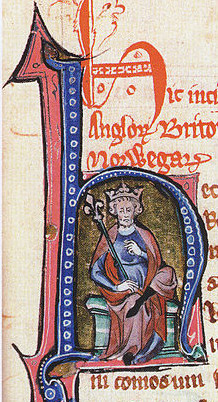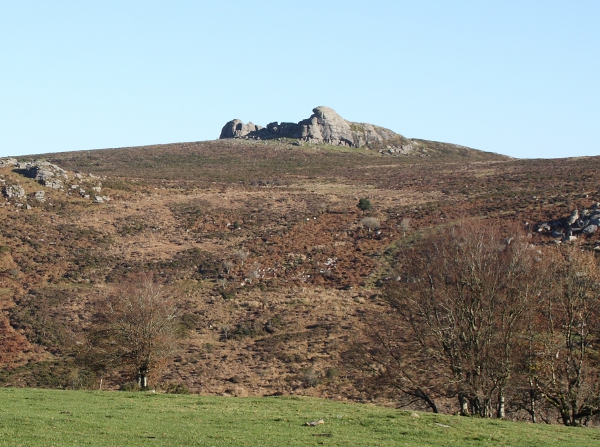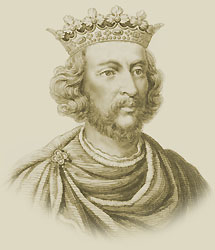
Contrary to the usual meaning of a forest as a large area covered mainly with trees, in early Mediaeval England from before the Norman Conquest forest had a different connotation. Royal Forests were tracts of land set aside for use by the monarch for hunting game. Such forests and the game therein were protected by an increasingly punitive legal code, the Forest Law, whose observance was overseen by designated officers of the crown.
The first known record of such Forest Laws - the Constitutiones de Foresta - dates from the reign of King Canute (1016-1035), though its authenticity has been challengednote1. The penalties for minor infringements under this code were fines for those with the wherewithal to pay, whereas serfs could be outlawed. The severest penalties were reserved for the killing of the most supreme royal beast - a stag - within the forest bounds: these were loss of liberty for a freeman, and death for a serf or bondman.
William the Conqueror was a keen huntsman, and with each successive Norman king ever more of the country was declared a Royal Forest, and the penalties for breaking the Forest Laws became more severe. Even during the Conqueror's reign punishments for taking Royal game involved mutilation, including the gouging out of eyes and removal of testicles. In wasn't until the Forest Charter enacted by the Regency of the boy-king Henry III in 1217 that a more liberal penal code was introduced; this charter declared that No man from henceforth shall lose either life nor member for killing our deer. Fines were reintroduced, with imprisonment for a year and a day for non-paymentnote2.
Manwood, in his Treatise of the Forest Laws first published in 1598 gives this definition of a Royal Forest:
As Manwood mentions, in addition to protecting the vert, the Forest Law offered strict protection for the wild beasts and fowl of the forest, chase, and warren. The beasts of the forest were the hart, the hind, the hare, the wild boar and the wolf. The beasts of the chase were the buck, the doe, the marten, the roe deer, and the fox, while the beasts and fowl of the warren were the cony, the pheasant and the partridge. Manwood tells us that, though the same five animals where known as beasts of the forest at the time, King Canute's forest laws made an exception of the wolf owing to its dangerous and hurtful nature. Killing a wolf in a Royal Forest was regarded as no more serious that killing a beast of the chase and was punishable by a modest fine. [Manwood[1], p161]
Though they were not enclosed in the physical sense, it was important that the forest boundaries were clearly delineated because the statutes of the Forest Law could only be applied to those guilty of trespass on forest land.
Afforestation became ever more widespread under the Norman kings, and several counties in their entirety, including Devon, were designated as forests. Enforcing the Forest Law over such a vast area was impractical, but, even though the penalties for transgression were harsh, what really made it such a deeply unpopular statute was the restrictions on enclosing, felling trees, and cultivation that it imposed on the freeholders owning land within the forest. It was eventually scaled back in Devon following a petition to King John, who in 1204 signed a charter for its disafforestation up to the borders of Dartmoor and Exmoor, as they were known at the time of King Henry I, in return for a total payment of 5,000 marks (or £3333) by the common people of the county.

The Forest of Dartmoor with its treeless wilderness and granite outcrops hardly fits Manwood's description of a forest, but the absence of enclosures was a Royal Forest's essential characteristic:
It is possible that in the Middle Ages Dartmoor had more woodland than can be seen today, though how much more is a matter of conjecture. However the 19th century topographers J Brooking Rowe and William Crossing opined that the extent of tree cover on the high moor was unlikely to have been significantly greater before their time.
From its establishment after the Norman Conquest, The Dartmoor Forest was attached to the manor or parish of Lydford, one of the four Saxon boroughs in Devon along with Exeter, Barnstaple and Totnes.
Alleged transgressions against the Forest Law were adjudicated using a multi-tiered court system. Offences occurring within Dartmoor Forest were processed in this way by courts sitting at Lydford. The lowest court was the Court of Attachment which convened every forty days. The function of this court was to make presentments to the Court of Swainmote which met three times a year, and whose jurors were normally drawn from the forest freeholders. If the indictment brought by the forest officers were proved the verdict was sealed, but sentence could only be passed by the Court of Justice Seat which convened once every three years.
Lydford Castle was subsequently appointed as the prison for felons convicted under the similarly harsh Stannary Laws, by which time Lydford had gained wide notoriety as the home of the barbaric form of justice known colloquially as Lydford Law, or 'hang first and try after', which was immortalized in a 1644 poem by William Browne of Tavistock, The Lydford Journey, which begins:
The court system used to administer the Forest Law, with the deferral of sentencing following conviction, provided an incentive for the application of Lydford Law: some writers have gone so far as to suggest that as the eventual sentence was a foregone conclusion it was expeditious for the Chief Warden to hang the convicted offender without further ado, rather than detain him for up to three years for the next sitting of the Court of Justice Seat to determine his fate.
This illustrates the propensity of earlier historians to exaggerate the severity of the penalties imposed under Forest Law, with an implicit assumption that all transgressions were punished by the same sentence as the only capital offence, namely the hunting and killing of a stag within the forest. In fact the penalties for hunting other beasts of the forest or for despoiling the vert were much less harsh, and were not out of kilter with the penal codes of the time.

In 1239 King Henry III decided to make a gift of the Forest of Dartmoor and Manor of Lydford to his brother Richard, Earl of Cornwall. Once the King had transferred ownership, according to law a forest should have become a chase, nevertheless it remains known as Dartmoor Forest to this day.
Crossing gives the original names of the bounds (as recorded by the perambulators in their return) as:
In the following Ordnance Survey map the bound markers are positioned according to the grid references given in Legendary Dartmoor. The penultimate bound, Chapel of St. Michael de Halgestoke, is not shown because its precise location is unknown. Hover on the marker to see an equivalent modern-day name for the each location.
Since 1982 Ian Kirkpatrick has acted as coordinator for teams wishing to undertake the challenge of completing the route of this perambulation. A certificate is awarded to those who succeed. The names of the 1200 people who have achieved this (up to December 2011), together with extracts from their reports can be found on Ian's website.